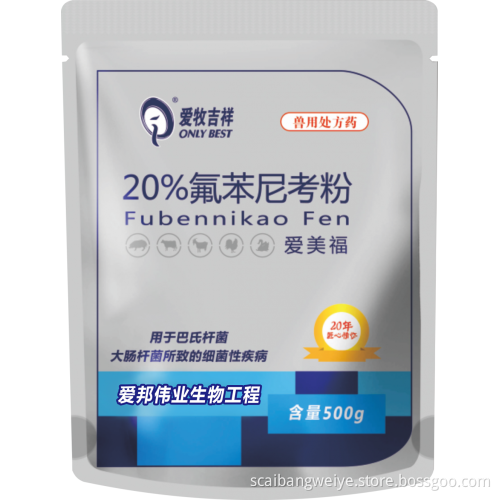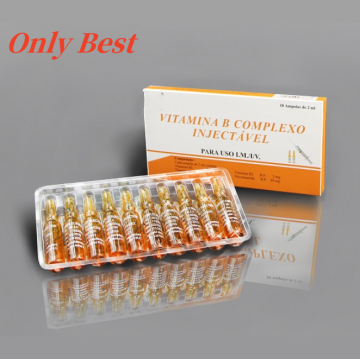
Best Selling Florfenicol Powder for Animals
- Transportation:
- Ocean, Land, Air
- Port:
- SHANGHAI, NINGBO, GUANGZHOU
Your message must be between 20 to 2000 characters
Contact Now| Place of Origin: | Sichuan, China |
|---|---|
| Payment Type: | L/C,D/P,D/A |
| Incoterm: | FOB,CIF,EXW,FCA |
| HS Code: | 3004101210 |
| Transportation: | Ocean,Land,Air |
| Port: | SHANGHAI,NINGBO,GUANGZHOU |
Description of Florfenicol Powder Rx
Generic name
:Florfenicol Powder
English name: Florfenicol powder
Chinese Pinyin :Fubennikao Fen
[Main ingredients] Florfenicol
[Properties] This product is white or white powder
[Pharmacological action] Pharmacodynamics Florfenicol is a broad-spectrum antibiotic
of amide alcohols, which is an antibacterial agent. It plays a role in
inhibiting the synthesis of bacterial proteins by combining with the 50S
subunit of ribosomal. It has strong antibacterial activity against a variety of
Gram-positive and Gram-negative bacteria. Pasteurella haemolyticus, Pasteurella
multocida and Actinobacillus suis pleuropneumonia are highly sensitive to
florfenicol. In vitro, florfenicol has similar or stronger antibacterial
activity than sulfoxamycin against many microorganisms. Some bacteria resistant
to amide alcohols due to acetylation, such as Escherichia coli and Klebsiella
pneumoniae, may still be sensitive to florfenicol. It is mainly used for
bacterial diseases caused by susceptible bacteria in pigs, chickens and fish. Such
as Pasteurella haemolyticus, Pasteurella multocida and Actinobacillus suis
pleuropneumonia caused by respiratory diseases in cattle and pigs. Typhoid
fever and paratyphoid fever caused by Salmonella, chicken cholera, chicken
dysentery, Escherichia coli disease, etc. Fish Pasteurella, Vibrio,
Staphylococcus aureus, hydrophila, enteritis bacteria caused by fish bacterial
septicemia, enteritis, erythroderma, etc.
Pharmacokinetics Florfenicol is rapidly absorbed by oral administration and
therapeutic concentrations can be reached in the blood after approximately 1
hour. Peak plasma concentrations were reached within 1-3 hours. The
bioavailability was more than 80%. Florfenicol is widely distributed in animals
and can cross the blood-brain barrier. It is excreted mainly in its original
form in the urine and to a lesser extent in the feces.
[Drug interactions] (1) Macrolides and lincosamines have the same target of
action as this product, which are bound to the 50S subunit of bacterial
ribosylation, and can produce antagonistic effects when combined.
(2) It may antagonize the bactericidal activity of penicillins or
aminoglycosides, but it has not been demonstrated in animals.
[ Action and use ] Amido alcohol antibiotics. They are
used for Pasteurella and Escherichia coli infections.
[ Usage and dosage ] Based on this product. For oral
use; 0.2 ~ 0.3g/lkg body weight for pigs and chickens, twice a day for 3 ~ 5
days; Fish 0.1-0.15 g, once a day, for 3 to 5 days.
[Adverse reactions] This product has a certain immunosuppressive effect when it
is used at a higher than the recommended dose.
[Precautions] (1) Chickens that produce eggs for human consumption. Shall not
be used during the laying period.
(2) Use breeder chickens with embryo toxicity, and use livestock during
pregnancy and lactation with caution.
(3) It is forbidden to use animals during vaccination or with severe immune
deficiency.
(4) For animals with renal insufficiency, the dose should be appropriately
reduced or the interval of administration should be prolonged.
[Off-drug period] 20 days for pigs, 5 days for chickens, and 375 degrees per
day for fish.
[Rest period] chicken 7 days.
[Specifications] 10%
[Packaging]
[Storage] Closed, stored in dry place.
[ Validity ]
[ Approval number ]
[ Production enterprise ]
Related Keywords








